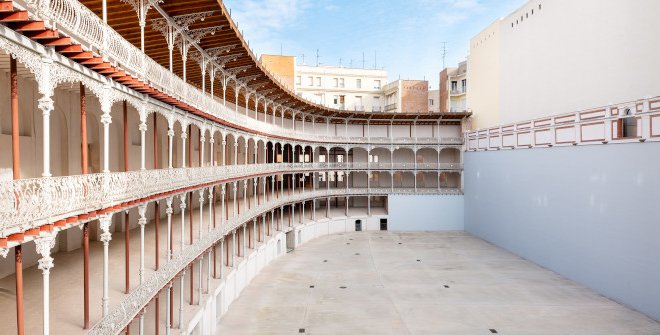Due to the popularity in the late 19th century of the age-old Basque pelota game, a frontón (or, pelota court) was built in Madrid to host sporting events. It served as a court for 25 years before being repurposed into a multifunctional space. In 1991, it was officially declared a National Monument. Now fully renovated, the site is open to the public free of charge, Tuesday through Sunday.
Architect Joaquín Rucoba—whose projects not only include Teatro Arriaga and City Hall in Bilbao, but also the bullring and Mercado de Atarazanas market in Malaga—was responsible for designing the Beti Jai Pelota Court in 1893, which takes its name from the Basque language. Years ago, a variation of the wall sport was exported and rebranded as jai alai, which translates as “joyful celebration”. With construction work completed a year later, the building with a capacity for up to 4,000 spectators was inaugurated on 29 April 1894 in the Chamberí district. Until 1918, it operated as a frontón before transitioning into a multifunctional space, serving various purposes over the years, including a garage, police station, prison, and a workshop for plaster and plasterboard, among other uses.
In 1991, the pelota court was declared a National Monument and later, in 2011, it was further recognised as an Asset of Cultural Interest (BIC). By 2015, Madrid City Council had acquired the Beti Jai, commencing renovation efforts aimed at preserving the essence of the building. During this process, thorough research was caried out (in the form of old newspapers, library documents, and collaboration with associations and experts) to ensure that the court retained as much of its original character as possible.
Permanent Reopening of the Pelota Court and Interpretation Centre

To coincide with its 130th anniversary, in March 2024 the Beti Jai Pelota Court was permanently opened to the general public. It's free to visit from Tuesday through Sunday, between 10:00am and 2:00pm, and it now features the Beti Jai Frontón Interpretation Centre, located within the galleries and corridors of this remarkable building in Chamberí. The centre offers visitors an insightful journey through the most significant moments in the history of this cultural treasure.